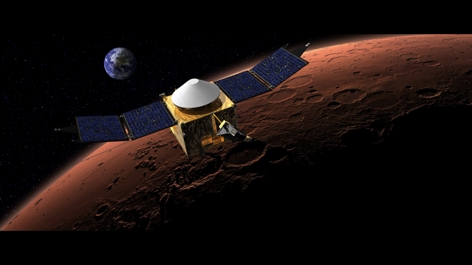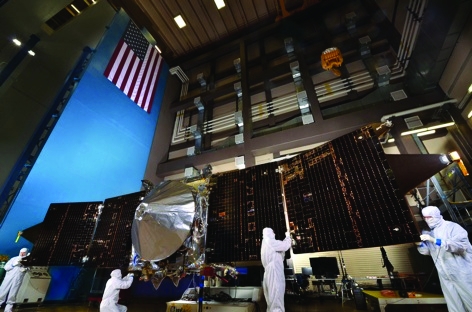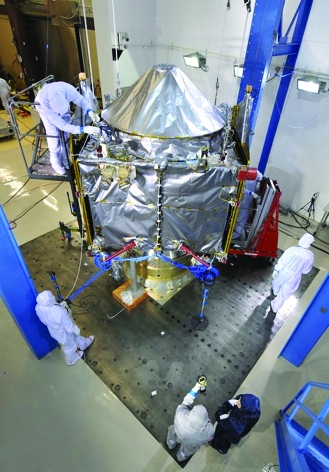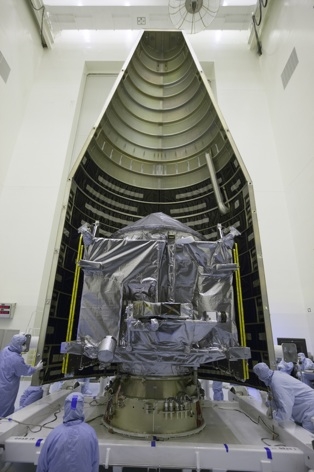Somewhere over our heads, a small capsule is just starting its journey across the inner solar system. NASA’s latest mission to Mars, the Mars Atmosphere and Volatile Evolution Mission (MAVEN), was launched this week from Cape Canaverel and, according to the iron laws of orbital mechanics, will reach the Red Planet next September.

There, it will perform an extraordinary series of manoeuvres, diving deep into the Martian atmosphere and climbing high above the planet in an elliptical orbit to take samples of the sparse atmospheric gases to try to answer a question that’s been nagging away at planetary scientists for decades: what happened to turn a planet with a dense atmosphere, flowing water at the surface and possible conditions for life into a cold, barren desert?
MAVEN’s elliptical orbit, varying from from 150km to 6000km above the planet with five ‘deep dips’ down to 125km up, will allow it to sample the atmosphere from the the upper layers down to the top of the well-mixed lower atnosphere, for its on-board instruments to analyse the mixtures of molecules and ions present at various altitudes. While at its furthest points, it will use ultraviolet imaging of the entire planet to determine what’s happening to the planet’s atmosphere today, such as the rate of gas loss and which gases are being lost fastest.
Sampling both the atmosphere and the space environment within the same mission will allow the MAVEN team to extrapolate backwards in time to determine the total amount of atmosphere the planet has lost to space. In particular, the team hopes it will tell them when and how Mars lost its water and carbon dioxide.
The main culprit for the loss of Mars’ atmosphere is believed to be the Sun. Mars, being smaller than the Earth, has a weaker gravitational field and therefore can’t hold on to its atmosphere so tightly. Moreover — and we don’t know why this is the case — it has no magnetic field, although it is believed to have had one some four billion years ago. So while Earth sits in a magnetic bubble which deflects the constant Solar Wind of charged particles from our local star, Mars is unprotected, and the Solar Wind is believed to have gradually stripped away the atmosphere the planet had in past aeons.

One confounding factor is that the water and CO2 could have gone in two directions — up or down: in other words, were they blown away into space, or did they seep undergound, freeze and form part of the planet’s crust?
This kind of science is new for Mars, but decades of experience in building planetary orbiters was vital for the design and construction of MAVEN, explained Jeff Coyne of Lockheed Martin, which built the probe. Coyne, who is assembly, test and launch operations manager, said that the experience of building Mars Reconnaisance Orbiter (MRO) — which was launched in 2005 and acts as a communications platform for NASA’s Mars rovers while also carrying out imaging and spectroscopic experiments — was extremely valuable in building MAVEN. ‘MRO means that we know a lot about the environment in space around Mars and during the cruise to the planet,’ Coyne said. ‘It also shows that we know we can get sufficient power for the spacecraft using solar panels rather than a nuclear power unit.’
Solar is the default option for powering spacecraft, with nuclear systems — which work by using the difference in temperature between a lump of radioactive plutonium oxide and the ambient conditions to generate electricity — used only when it’s the only option. The Curiosity rover, for example, uses a nuclear power source, which allows it to continue operating during the Martian night and when it’s in shadow. ‘We even used solar panels on [Jupiter probe] Juno, although I would sure have liked to use nuclear on that,’ he said. ‘We’re very comfortable with engineering with solar cells, and the sun is easily strong enough at Mars.’

The construction procedure for NASA probes follows a very similar path to ESA’s exploratory spacecraft. The various academic institutions leading the probe’s science mission design and build their own instruments and send them to the spacecraft builders for incorporation into the spacecraft body and integration into its electronics and communication system. MAVEN carries three suites of instruments: the Particles and Fields Package, which contains six instruments, four from the Space Sciences Laboratory at the University of California at Berkeley; one co-built between Berkeley and the University of Colorado at Boulder Laboratory for Atmospheric and Space Physics (LASP), and one from NASA’s Goddard Space Flight Center; these instruments will study and characterise the solar wind and the ionosphere of Mars. The Remote Sensing Package, from Boulder, will look at the global characteristics of the upper atmosphere and ionosphere using ultraviolet spectroscopy. The Neutral Gas and Ion Mass Spectrometer, built by NASA Goddard, will measure the composition and isotopic abundances of neutral atoms and molecules and ions in the atmopshere.
All of these will face somewhat larger radiation doses than, for example, Earth observation spacecraft, said Coyne. ‘Barring solar flares and cosmic rays, the radiation environment is pretty uniform, and we don’t need any extraordinary shielding,’ he said. ‘Most of the components — the ones we supply and the ones in the instruments — are hardened against radiation, and just being inside the spacecraft body gives us protection enough.’

The spacecraft’s shape, particularly its gull-wing solar panels, is designed to allow it to withstand the temperature increase it will experience as it dives into the upper layers of Mars’s atmosphere — nothing like the inferno experienced by spacecraft entering Earth’s atmosphere, but still enough to require special design, Coyne said; the gull-wing shape gives extra stability to the arrays.
But despite the instrumentation suites on board the spacecraft, MAVEN won’t be able to provide the full picture alone. The Martian atmosphere is a complex system, with the solar wind, the surface and the deep interior of the planet all playing a part in its composition. In order to turn the clock back and determine whether an environment suitable for microbial life ever existed — and if so, when — the science team, led by the group at LASP under Prof Bruce Jakoski, will have to combine its results with those from other spacecraft, including ESA’s Mars Express, already in orbit, and India’s Magalyaan, which was launched in early November.




Glasgow trial explores AR cues for autonomous road safety
They've ploughed into a few vulnerable road users in the past. Making that less likely will make it spectacularly easy to stop the traffic for...